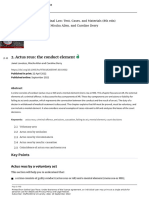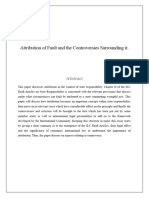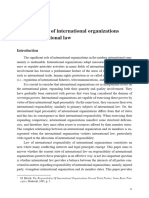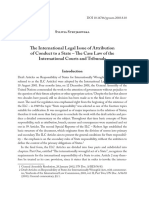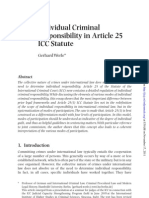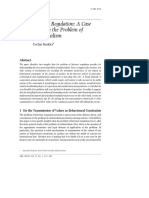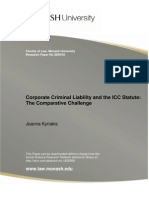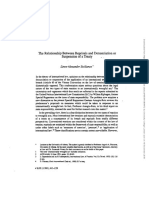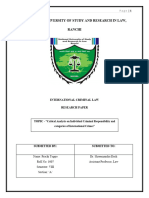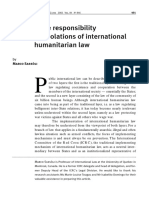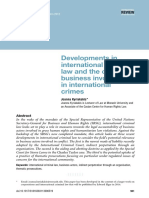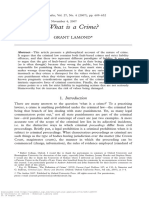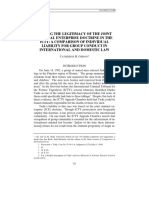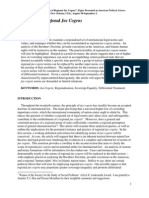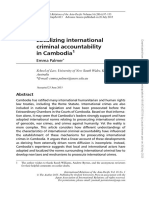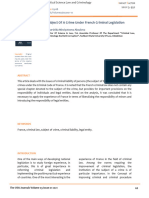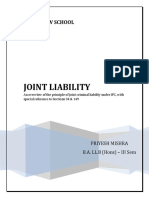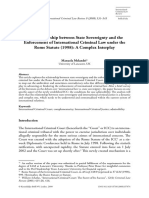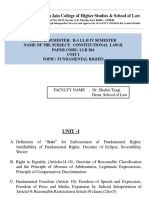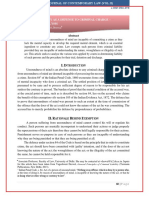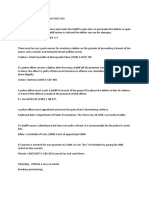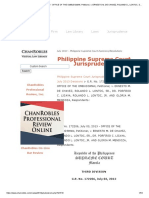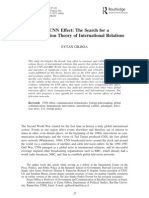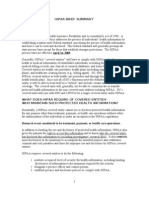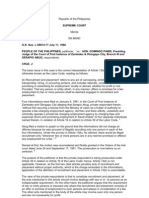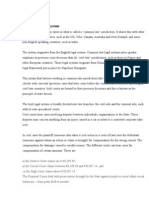The Actus Reus of The Crime of Aggression: Nikola R. Hajdin
The Actus Reus of The Crime of Aggression: Nikola R. Hajdin
Uploaded by
Lûv Kûmár ThákûrCopyright:
Available Formats
The Actus Reus of The Crime of Aggression: Nikola R. Hajdin
The Actus Reus of The Crime of Aggression: Nikola R. Hajdin
Uploaded by
Lûv Kûmár ThákûrOriginal Title
Copyright
Available Formats
Share this document
Did you find this document useful?
Is this content inappropriate?
Copyright:
Available Formats
The Actus Reus of The Crime of Aggression: Nikola R. Hajdin
The Actus Reus of The Crime of Aggression: Nikola R. Hajdin
Uploaded by
Lûv Kûmár ThákûrCopyright:
Available Formats
The Actus Reus of the Crime of Aggression
Nikola R. Hajdin*
Abstract
To adjudicate a claim on individual criminal responsibility, the court has to establish objective
and subjective links between the individual and the crime. This article studies the material (actus
reus/objective) elements of the crime of aggression (conduct, consequence and circumstance) and
suggests a reading that solves most of the conceptual and practical issues regarding criminal
responsibility for this crime. The main contribution is an ontological distinction between the
material act of use of violence and the act of aggression, which are both subsumed under the term
‘state/collective act’. The former is a consequence element and therefore is to be understood in its
naturalistic meaning—a perceivable result of one’s action. The latter is a legal-evaluative notion
and as such constitutes a circumstance that renders the violation of the prohibitory norm (the
union of conduct and consequence) as being wrongful. This distinction is crucial for the system of
attribution of criminal responsibility, as different mental (subjective) elements apply to
consequences and circumstances.
Key words: crime of aggression—actus reus—material elements—Rome Statute—ICC
*
Doctoral candidate in international law, Stockholm University. Email: nikola.hajdin@juridicum.su.se
This article was written during my fellowship at the Institute for Global Law and Policy at Harvard Law School. The
time I spent in the US enabled me to discuss my theory with some of the most prominent international law figures of
our time, and for that I am indebted to David Kennedy. For potent contributions and insightful comments on the text,
I am grateful to Thomas Weigend, Roger Clark, Christoffer Wong, Sergey Vasiliev, Beth van Schaack, Pål Wrange,
Elies van Sliedregt, Dustin A. Lewis, George P. Fletcher, Tom Dannenbaum, and participants in the workshop
organized by the Harvard Law School Program on International Law and Armed Conflict. As for mistakes, the buck
stops with me.
Electronic copy available at: https://ssrn.com/abstract=3727821
1. Introduction
Aggression is a particularly grave and manifestly illegal use of force by a state. The crime of
aggression criminalizes individuals for their contributions to state aggression.1 Since 17 July 2018,
the crime is fully operational at the International Criminal Court (ICC).2 Much has been written
about the crime and its future prospects. However, the question of who is to be held accountable
for aggression remains puzzling. There is clear consensus among international lawyers that only
leaders ought to be blamed for aggression.3 This proposition dates back to the post-WWII trials,
where the prevailing opinion was that only the policy makers could be responsible for the crime.4
Since then, it has been generally accepted that only high-ranking state agents can be held
responsible for the crime of aggression, whereas common foot soldiers and followers ought to be
excluded from criminal responsibility.5 To this end, Article 8bis of the Statute of the International
Criminal Court (Rome Statute)6 defines the crime of aggression as follows:
For the purpose of this Statute, “crime of aggression” means the planning, preparation, initiation or execution, by a person in a
position effectively to exercise control over or to direct the political or military action of a State, of an act of aggression which,
by its character, gravity and scale, constitutes a manifest violation of the Charter of the United Nations.
This so-called ‘leadership clause’ (‘a position effectively to exercise control over or to direct the
political or military action’) is also referred to in Article 25 of the Rome Statute, which stipulates
1
Traditionally, the norms on aggression in international law have been understood to bind states only. See C. Kreβ,
‘The State Conduct Element’, in C. Kreβ and S. Barriga (eds), The Crime of Aggression: A Commentary (2017) 412,
at 412.
2
ICC-ASP/16/ Res.5.
3
Virtually every commentator tackling the issue of criminal responsibility for the crime of aggression has accepted
the notion of leadership responsibility. See e.g. D. Akande and A. Tzanakopoulos, ‘The Crime of Aggression before
the International Criminal Court: Introduction to the Symposium’ (2018) 29 European Journal of International Law
829, at 829. The authors take it as an axiom that only leaders may be prosecuted for aggression.
4
United States v. von Leeb et al., Military Tribunal XII (hereinafter High Command Judgment), 11 Trials of War
Criminals Before the Nuremberg Military Tribunals Under Control Council Law No. 10 (1950), at 488.
5
See M. Gillett, ‘The Anatomy of an International Crime: Aggression at the International Criminal Court’, (2013) 3
International Criminal Law Review 829, at 860.
6
Statute of the International Criminal Court, Art. 5, UN Doc A/Conf.183/9 (1998).
Electronic copy available at: https://ssrn.com/abstract=3727821
that the article’s provision on modes of criminal responsibility applies only to a person who meets
the requirements of this clause.7 Given that there is no analogous jurisprudence to guide the
interpretation of the clause,8 what constitutes leadership in this context is a question that the ICC
will have to deal with.
The essence of individual criminal responsibility is the appraisal of individual contribution
against the requirements imposed by the basic structure of international crimes.9 Pursuant to the
Rome Statute, international crimes consist of material (actus reus/objective) and mental (mens
rea/subjective) elements. In order to establish guilt, the court has to make objective and subjective
links between the accused and the offence in question.10 The objective aspect is further broken
down into conduct, consequence and circumstance, while the subjective aspect consists of intent
and knowledge. Whilst mental elements are quite straightforward,11 what constitutes conduct,
consequence and circumstance is not as obvious. It is the collective act that ‘bedevil[s] the crime
of aggression…[and] complicates individual criminal responsibility’.12 In particular, there is
confusion about whether the collective act (intrinsic to the crime) is a consequence or a
circumstance element.
The distinction between material elements is crucial for at least three reasons. First,
different mental elements apply to conduct, consequence and circumstance. Second, as a rule,
individuals are blamed for the caused wrong that is manifested in the consequence element of the
7
Art. 25(3bis) ICCSt.
8
The leadership standard applicable during the WWII trials was ‘shape or influence’. For a comprehensive account,
see N. Hajdin, ‘The Nature of Leadership in the Crime of Aggression: The ICC’s New Concern?’, (2017) 17
International Criminal Law Review 543.
9
See Section 2 below.
10
See T. Weigend, ‘Problems of Attribution in International Criminal Law: A German Perspective’ (2014) 12 Journal
of International Criminal Justice (2014) 253, at 254.
11
Intent and knowledge refer to material elements. See Art. 30 ICCSt.
12
T. Dannenbaum, ‘Aggression and Atrocity: The Interstate Element, Politics, and Individual Responsibility’ in E.
Conze and S. Bock (eds), Rethinking the Crime of Aggression: International and Interdisciplinary Perspectives
(forthcoming). Available at SSRN https://papers.ssrn.com/sol3/papers.cfm?abstract_id=3383214, at 6.
Electronic copy available at: https://ssrn.com/abstract=3727821
crime and not for the surrounding circumstances in which the criminal act took place.
Circumstances exist irrespective of the perpetrator’s conduct.13 Third, the leadership clause
requires that a perpetrator ‘control or direct’ ‘state action’. Given the surrounding confusion, state
action (collective act) could be interpreted as either a consequence or a circumstance element or
both. Therefore, a proper understanding of the actus reus of the crime of aggression would help
situate the leadership clause within the objective-subjective paradigm, assist in its correct
interpretation, and ultimately answer the questions of who is to be blamed and for what.
In this article I suggest a reading of the actus reus of the crime of aggression, focusing
primarily on understanding conduct and distinguishing between consequence and circumstance.
The main contribution the article makes is the distinction between the material act of use of
violence and the normative term ‘act of aggression’, both of which are subsumed under
‘state/collective act’. The discussion concerning the leadership requirement (a circumstance
element) is left for a follow-up to this piece. The remainder of this article is structured as follows.
Section 2 briefly lays out the objective and subjective elements that underpin international crimes.
To establish one’s criminal responsibility, the court must perform an assessment against the
backdrop of the basic structure of international crimes. In other words, the court has to draw
objective and subjective links between the accused and the crime. Subsequently, the article
analyses the actus reus trichotomy of the crime of aggression. Section 3.1. suggests a reading of
conduct not as planning, preparation, initiation and execution but rather as a contribution to one
of these stages. Section 3.2. makes a distinction between the material act of use of violence and
the normative term ‘act of aggression’, whereby the former is the consequence and the latter the
circumstance element. Section 4 summarises the main findings of the article.
13
See Section 3.2. below.
Electronic copy available at: https://ssrn.com/abstract=3727821
2. The basic structure of international crimes
The structure of international core crimes can be conceptualized along two axes. Leaving a broader
theoretical discussion aside,14 it is now well-accepted in international criminal law that
international crimes consist of material and mental elements.15 The former is further broken down
into conduct, consequence, and circumstance, while the latter presupposes a required state of mind
(intent and knowledge), viz. the psychological relationship between the offender and the offence.16
This approach emanates from the common law tradition and was adopted at the tribunals for the
former Yugoslavia and Rwanda. Article 30 of the Rome Statute prescribes the necessary mental
elements and is seen as a general provision in international criminal law.17 As a rule,18 in order to
be blamed for the crime in question, the person has to voluntarily engage in the conduct, be aware
of all required circumstances prescribed by the specific crime, and be virtually certain that the
consequence will occur.19 The Rome Statute does not have an analogous provision on material
elements; rather, they are listed in the definitions of the crimes (Arts 6–8bis).20 Moreover, the
Elements of Crimes focus on the material elements that are associated with each core crime.21
The mental and material elements of crimes constitute what might be referred to as the
basic structure of international crimes. There is no criminal responsibility if the accused’s
involvement is not appraised against this backdrop. In other words, a person is to be found guilty
only if she has an objective and subjective relationship with the crime. The following section
14
K. Ambos, Treatise on International Criminal Law, Volume I: Foundations and General Part (2013), at 99–100.
Ambos states that case law suggests a twofold structure of international crimes based on the common law dichotomy
between offence and defence and, at the level of the former, between material and mental elements.
15
See G.P. Fletcher, The Grammar of Criminal Law: American, Comparative, and International (2007) at 46.
16
See A. Cassese, International Criminal Law (3rd ed., 2013), at 38–39.
17
Ambos, supra note 14, at 266.
18
Article 30 starts with ‘Unless otherwise provided’, which means that it applies to all situations where the crime in
question does not require a different mental element(s). See Art.30(1) ICCSt.
19
(emphasis added).
20
See W. Schabas, The International Criminal Court: A Commentary on the Rome Statute (2nd ed., 2016), at 630.
21
See ICC Elements of Crimes, General introduction, para. 7.
Electronic copy available at: https://ssrn.com/abstract=3727821
studies conduct, consequence and circumstance for the crime of aggression. The accompanying
mental elements will only be briefly mentioned, as they can easily be understood by plain reading
of Article 30 of the Rome Statute.22
3. Material elements
Material elements determine whether the individual acted wrongfully, and wrongfulness is nothing
other than a breach of a prohibitory norm23—a norm that prohibits the criminal conduct. It was
only in the later stage of the drafting process prior to Kampala Review Conference 2010 that the
Special Working Group for the Crime of Aggression (SWGCA) shifted its focus from a ‘complex
discussion on entry-into-force procedures’24 to writing amendments to the Elements of Crimes
with regard to the crime of aggression. In April 2009, 23 experts were invited to an informal
meeting held in Montreux, Switzerland, to discuss in their personal capacity future elements of the
crime. This meeting was inspired by the draft proposal prepared by Australia and Samoa.25 The
SWGCA Chair subsequently based his 2009 Chairman’s Non-paper on the Elements of Crimes on
the conclusions reached in Montreux.26 The final version of the Elements of Crimes was adopted
in Kampala 2010 and reads as follows:
Article 8 bis
Crime of aggression
Introduction
22
For a good account of the mental elements of the crime of aggression, see N. Weisbord, ‘The Mens Rea of the Crime
of Aggression’ (2013) 12 Washington University Global Studies Law Review 487.
23
‘The standard cases of criminal liability are those in which an individual violates a prohibitory norm’. See G.P.
Fletcher GP, Rethinking Criminal Law (2000) at 581.
24
See S. Barriga, ‘Negotiating the Amendments on the Crime of Aggression’ in C. Kreß and S. Barriga (eds), The
Travaux Préparatoires of the Crime of Aggression (2012) 3, at 36–41.
25
F. Anggadi, G. French and J. Potter, ‘Negotiating the Elements of the Crime of Aggression’ in C. Kreß and S.
Barriga (eds), The Travaux Préparatoires of the Crime of Aggression (2012) 58, at 63.
26
‘2009 Chairman’s Non-Paper on the Elements of Crimes’, reprinted in C. Kreβ and S. Barriga (eds), The Travaux
Préparatoires of the Crime of Aggression (2012) 677.
Electronic copy available at: https://ssrn.com/abstract=3727821
1. It is understood that any of the acts referred to in article 8 bis, paragraph 2, qualify as an act of
aggression.
2. There is no requirement to prove that the perpetrator has made a legal evaluation as to whether the
use of armed force was inconsistent with the Charter of the United Nations.
3. The term “manifest” is an objective qualification.
4. There is no requirement to prove that the perpetrator has made a legal evaluation as to the “manifest”
nature of the violation of the Charter of the United Nations.
Elements
1. The perpetrator planned, prepared, initiated or executed an act of aggression.
2. The perpetrator was a person in a position effectively to exercise control over or to direct the political
or military action of the State which committed the act of aggression.
3. The act of aggression – the use of armed force by a State against the sovereignty, territorial integrity
or political independence of another State, or in any other manner inconsistent with the Charter of the
United Nations – was committed.
4. The perpetrator was aware of the factual circumstances that established that such a use of armed force
was inconsistent with the Charter of the United Nations.
5. The act of aggression, by its character, gravity and scale, constituted a manifest violation of the
Charter of the United Nations.
6. The perpetrator was aware of the factual circumstances that established such a manifest violation of
the Charter of the United Nations.
What follows is a discussion regarding the three constitutive material elements, namely, conduct,
consequence and circumstance. Paragraphs 1 to 6 under sub-heading ‘Elements’ will henceforth
be referred to as Elements 1 to 6.
3.1. Conduct
In its literal translation, actus reus means ‘guilty act’. However, stricto senso, it is the conduct that
denotes an action or omission that is contained in the definition of a specific crime.27 An action
always renders a change in the material world (e.g. firing of a pistol). Conversely, an omission is
27
Cf. section 1.13 of the Model Penal Code (MPC): ‘conduct’ is ‘an action or omission and its accompanying state of
mind, or, where relevant, a series of acts and omissions’; for example, an action could be ‘planning’ of the crime of
aggression; see Art. 8bis(1) ICCSt; an example of omission is ‘starvation of civilians as a method of warfare’ in armed
conflict, Art. 8(2)(b)(xxv) ICCSt.
Electronic copy available at: https://ssrn.com/abstract=3727821
non-performance of an action in instances where there is a legal duty to perform. In the criminal
law context, actions are exclusively human products.28 In other words, they are always attributable
to a human person. Consider, as an example, drone strikes. In the pursuit of a legitimate military
aim, a highly sophisticated unmanned aircraft autonomously performs what could be considered
the conduct element of actus reus (e.g. bombing of a village and killing civilians in the midst of
armed conflict). Yet, it is not the object (drone in this case) that will incur criminal lability but a
human being to whom this action ought to be imputed. The drone is merely a means to an end.
Element 1 and Article 8bis of the Rome Statute define the conduct of the crime of
aggression as planning, preparation, initiation or execution of an act of aggression. The conduct
verbs are very similar to the respective provisions in the charters of international military tribunals
in Nuremberg and Tokyo, which referred to ‘planning, preparation, initiation or waging’ of an
aggressive war.29 The replacement of ‘waging’ with ‘execution’ follows linguistic coherence given
that the term ‘war of aggression’ was replaced by ‘act of aggression’.30 The term ‘act’ is temporally
more determined than the term ‘war’ in that the latter entails a lapse of time in which the former
occurs. It follows that one does not wage an act of aggression but rather executes it.31
Defining conduct as planning, preparation, initiation or execution came as a result of the
adoption of the so-called ‘differentiated’ approach during the negotiations prior to Kampala 2010.
28
The MPC considers in Section 1.13 ‘act’ or ‘action’ exclusively as a bodily movement.
29
See Art. 6(a) of the London Charter and Art. 5(a) of the Statute of the International Military Tribunal for the Far
East.
30
See E. Freiburg and A. Zimmermann, ‘Article 8bis. Crime of Aggression’ in K. Ambos and O. Triffterer (eds), The
Rome Statute of the International Criminal Court (3rd ed., 2016) 580, at 587.
31
On this point, see C. McDougall, The Crime of Aggression under the Rome Statute of the International Criminal
Court (2013), at 188–189.
Electronic copy available at: https://ssrn.com/abstract=3727821
By the same token, the competing ‘monistic’ approach32—originally propounded in July 200233—
suggested the exclusion of the application of different modes of criminal responsibility contained
in Article 25 of the Rome Statute.34 Accordingly, the conduct element of the crime of aggression
was defined in the 2002 paper as follows (see italics):
For the purpose of the present Statute, a person commits a “crime of aggression” when, being in a
position effectively to exercise control over or to direct the political or military action of a State, that
person intentionally and knowingly orders or participates actively in the planning, preparation,
initiation or execution of an act of aggression which, by its character, gravity and scale, constitutes a
flagrant violation of the Charter of the United Nations.35
This approach was labelled monistic, as it does not differentiate between the commission of the
crime (principal responsibility) and other forms of participation (complicity).36 Consequently, the
terms ‘orders’ and ‘participates’ exhaustively define the conduct.37 Conversely, the differentiated
approach suggested the application of the entire Article 25 of the Rome Statute to the crime of
aggression with all forms of responsibility therein.38 This approach contained three elements: the
applicability of the entire Article 25, the addition of the leadership clause thereto, and the
description of the conduct element.39 Furthermore, it was decided that the chapeau of the crime
has to contain the conduct verb(s) in order to describe what the perpetrator’s commission actually
means, which ultimately is not an easy task.40 Nonetheless, in 2007, consensus on the differentiated
32
Both ‘monistic’ and ‘differentiated’ labels were adopted during the sessions exclusively for the sake of convenience,
mainly because the former does not differentiate between the commission of the crime (principal responsibility) and
complicity (accessorial responsibility), whereas the latter does. See ‘2005 Discussion Paper 1’ reprinted in C. Kreβ
and S. Barriga, The Travaux Préparatoires of the Crime of Aggression (2011) (hereinafter Discussion Paper 1) 471,
at 472.
33
See ‘2002 Coordinator’s Paper (July)’ reprinted in C. Kreβ and S. Barriga, The Travaux Préparatoires of the Crime
of Aggression (2011) 412.
34
Ibid. at 412 (para 3).
35
Ibid. at 412.
36
See Discussion Paper 1, at 472.
37
Ibid.
38
Ibid.
39
Ibid, at 473.
40
The negotiation process stumbled over the issue of conduct verbs at some point. Delegations suggested different
verbs, and it was not clear which of the approaches would ultimately prevail. Roger Clark, who was present at the
time, noted: ‘[t]he search for an appropriate conduct word continued over the next couple of years. Both the monist
approach and the differentiated approach had their adherents, but the differentiated one was slowly winning. Various
Electronic copy available at: https://ssrn.com/abstract=3727821
approach was finally reached, setting on the conduct verbs such as ‘planning, preparation,
initiation or execution’.41
What is clear outright from the disjunctive ‘or’ is that conviction is secured if the
prosecution proves that the accused performed only one action caught by the conduct verbs. As to
the exact meaning of each of the conduct verbs, there seems to be a consensus in scholarship that
the Nuremberg and Tokyo precedents are not very helpful in deciphering the terms.42 McDougall
appraised a large chunk of post-WWII case law43 and went further to say that ‘it is impossible to
draw firm conclusions in relation to the definition of the terms “planning”, “preparing’ or
“initiating”, given the lack of consideration given to these terms’.44 Her conclusion is that the
courts sought to stress the significance of individual contribution rather than expounding on the
conduct verbs. Roger Clark similarly thinks that the courts in the aftermath of WWII were not
particularly helpful in defining the terms.45 Yet, there is some guidance to be found in legal sources
that, when coupled with the literal meaning of the terms, could bring us closer to understanding.
new verbs, such as “organize” and “lead” (“what leaders do”), were mooted and found wanting.’ R. Clark, ‘Individual
Conduct’ in C. Kreβ and S. Barriga (eds), The Crime of Aggression: A Commentary (2017) 565, at 580.
41
The SWGCA report from December 2007 reads: ‘[t]he [Chairman’s] non-paper met with broad agreement among
delegations, and no suggestions for improving its first paragraph were made. It was emphasized that the first paragraph
of the non-paper duly reflected the leadership nature of the crime. Delegations commended the fact that the same
structure was used as for other crimes under the Statute. Furthermore, by using the phrase “planning, preparation,
initiation or execution”, the text closely mirrored the language used at Nuremberg. The use of this phrase also avoided
the difficult choice of a conduct verb to link the conduct of the individual to the act of State, and was considered
altogether an elegant solution.’ ‘2007 SWGCA Report (December)’ reprinted in C. Kreβ and S. Barriga, The Travaux
Préparatoires of the Crime of Aggression (2011) 584, at 585.
42
E.g. R. Cryer et al. state that ‘[i]t is difficult to distinguish planning from perpetration in jurisprudence.’ R. Cryer
et al., An Introduction to International Criminal Law and Procedure (3rd ed, 2014), at 314; Roger Clark thinks that
the analysis of the Nuremberg judgment is not helpful at all in this respect, see R. S. Clark, ‘Nuremberg and the Crime
against Peace’, (2007) 6 Washington University Global Studies Law Review 527; McDougall suggests that ‘[w]hile
the IMT identified the positive acts of each accused that advanced the Nazi’s aggressive plans for war, it provided
little indication of whether such conduct should properly be defined as “planning”, “preparing”, “initiating” or
“waging” wars of aggression’, C. McDougall, ‘The Crimes against Peace Precedent’ in C. Kreβ and S. Barriga (eds),
The Crime of Aggression: A Commentary (2017) 49, at 85.
43
See ibid. (McDougall).
44
Ibid., at 100.
45
See Clark, supra note 40, at 567.
10
Electronic copy available at: https://ssrn.com/abstract=3727821
3.1.1. ‘Planning, preparation, initiation or execution’ as conduct verbs
The literal definition of planning is ‘to arrange in advance (an action or proposed proceeding)’, ‘to
devise, contrive, or formulate (a project or manner of proceeding)’, ‘to lay out in a plan’.46
Accordingly, one’s participation in devising a plan is what is criminalized. The term ‘plan’ is
defined as ‘[a]n organized (and usually detailed) proposal according to which something is to be
done’.47 Freiburg and Zimmermann argue that this means that the perpetrator has to be physically
present and give his input during the crucial meetings where the plan for the specific act of
aggression is devised.48 The criminalization reaches as far as the development of specified plans
and operations towards the commission of the particular state action in question.49
Preparation has a similar meaning as planning. Looking at the Nuremberg judgment, the
ILC held that ‘[t]he terms “planning” and “preparation” of a war of aggression were considered
by the Tribunal as comprising all the stages in the bringing about of a war of aggression from the
planning to the actual initiation of the war. In view of that, the [International Military] Tribunal
did not make any clear distinction between planning and preparation. As stated in the judgment,
“planning and preparation are essential to the making of war”.’50 According to the Oxford English
Dictionary, preparation means ‘[t]he action of preparing something’, ‘[t]hings done to get ready
for an event or undertaking’.51 Hence, if planning denotes participation in devising a proposal for
46
"plan, v.". OED Online. March 2019. Oxford University Press.
http://www.oed.com.ezp.sub.su.se/view/Entry/145023?rskey=Rl5rIQ&result=1&isAdvanced=false (accessed
August 17, 2020)’
47
"plan, n.". OED Online. March 2019. Oxford University Press.
http://www.oed.com.ezp.sub.su.se/view/Entry/145022?rskey=MEfbwo&result=1&isAdvanced=false (accessed
August 17, 2020).
48
See Freiburg and Zimmermann, supra note 30, at 589.
49
Ibid.
50
ILC, ‘Principles of International Law Recognized in the Charter of the Nuremberg Tribunal and in the Judgment of
the Tribunal’, Yb ILC (1950), vol. II at 374, para. 116
51
"preparation, n.". OED Online. March 2019. Oxford University Press.
http://www.oed.com.ezp.sub.su.se/view/Entry/150437?redirectedFrom=preparation (accessed August 17, 2020).
11
Electronic copy available at: https://ssrn.com/abstract=3727821
action, preparation refers to subsequent and sometimes simultaneous acts of creating conditions
that enable such action, for example, creating a public option of the necessity of war through the
mainstream media, acquiring weapons, recruiting troops and getting them ready for warfare, and
so on.52
Initiation denotes the commencement of the use of force required by the definition of the
crime of aggression.53 The Oxford English Dictionary describes initiation as the act of beginning
or starting something.54 At the Nuremberg Military Tribunal, initiation was described as ‘… a
unilateral operation. When war is formally declared or the first shot is fired the initiation of the
war has ended and from then on there is a waging of war between the two adversaries.’55 The term
captures actions on the strategic level pertaining to decisions directly leading to the use of force,
as opposed to decisions to act aggressively (planning stage) and decisions at the tactical level that
are subsequent to initiation of the state action.56
As execution replaced Nuremberg’s ‘waging’, there is no case law or any clarification from
the SWGCA regarding this element. According to the dictionary, the term ‘execution’ denotes ‘the
action of carrying into effect (a plan, design, purpose, command, decree, task, etc.)’.57 This stage
is subsequent to initiation and therefore encompasses all further actions in furtherance of
aggression. Given the leadership nature of the crime, execution is confined to contributions of
individuals of greater importance. This argument is in line with the basic premise of the leadership
52
See also McDougall, supra note 31, at 187.
53
See Freiburg and Zimmermann, supra note 30, at 590.
54
‘The action of beginning, entering upon, or “starting” something; the fact of being begun; beginning,
commencement, origination.’ See "initiation, n.". OED Online. March 2019. Oxford University Press.
http://www.oed.com.ezp.sub.su.se/view/Entry/96069?redirectedFrom=initiation (accessed August 17, 2020).
55
High Command Judgment, at 485.
56
Here the leadership requirement precludes responsibility of those who make decisions on a ‘micro-strategic’ or
tactical/operational level. See McDougall, supra note 31, at 188.
57
"execution, n.". OED Online. March 2019. Oxford University Press.
http://www.oed.com.ezp.sub.su.se/view/Entry/66007?rskey=g8H4fX&result=1&isAdvanced=false (accessed August
17, 2020).
12
Electronic copy available at: https://ssrn.com/abstract=3727821
requirement: the crime of aggression is a leadership crime that excludes followers from criminal
responsibility. A scenario in which a leader presses a button as a final stage prior to dropping
bombs from an aircraft is also conceivable.
3.1.2. ‘Planning, preparation, initiation or execution’ as stages prior to
aggression
The conduct element is constituted by the integrated conduct verbs: ‘planning an act of
aggression’, ‘preparing an act of aggression’, ‘initiating an act of aggression’ and ‘executing an
act of aggression’. Unlike the other core crimes, the consequence is the same for all of the conduct
verbs.58 Therefore, another way to look at planning, preparation, initiation or execution is through
a prism of stages prior to collective action. Following the linguistic account above, the verbs denote
chronological steps that follow one another in bringing about the collective act. This is readily
understandable from a plain reading of the terms. To this end, it is true that in order for a
synchronized collective action to occur, a proposal of some kind must first be made. Preparations
for the execution of such a plan have to follow logically. As a third step, strategic decisions have
to be made to narrow down the object that will be absorbed by the action. Finally, in a collective
endeavour, someone has to order the beginning of the course of action. The ultimate product or
the result of such a collective endeavour is a change in the natural world—in this case the use of
violence.59 From a legal perspective, these are the stages seen as crucial prior to occurrence of the
criminal result since it suffices that an accused is involved in only one of them.
58
See the following section.
59
Section 3.2.2. below develops this argument by suggesting that the consequence element of the crime of aggression
is the material act of use of violence.
13
Electronic copy available at: https://ssrn.com/abstract=3727821
In light of the foregoing, conduct is better read as being a contribution to one of the stages
prior to the consequence of the crime. This is true for the other core crimes as well.60 The difference
between the crime of aggression and the other three core crimes (genocide, crimes against
humanity and war crimes) is that the latter do not explicitly contain in their definitions the stages
prior to the criminal activity. Whenever there is an element of collectiveness implied in the
commission of a certain act, there are at least two stages prior to action, viz. planning and execution
of an act. Of course, a soldier may murder or rape someone during an armed conflict on a whim
and thus commit a war crime. However, there is no element of collectiveness in such a case, and
therefore the only stage of criminal activity is execution.
According to the current doctrine at the ICC, the person in control over the commission of
the crime is responsible for the offence as the perpetrator. ‘Control’ can be exerted not only by
those who ‘physically carry out the objective elements of the offence but also … [by] those who,
in spite of being removed from the scene of the crime … mastermind its commission because they
decide whether and how the offence will be committed’.61 ICC Pre-Trial Chamber I defined the
‘control’ required for perpetration as an essential contribution to the commission of the crime.62
By the same token, complicity at the ICC requires a significant contribution to a group’s effort as
a requirement for individual criminal responsibility.63
To sum up, as a rule, contribution to the consequence of the crime is what is required by
conduct under the Rome Statute. Given the collective nature of the core crimes, multiple
individuals could be criminally responsible without physically bringing about the specific
60
Furthermore, this is true for any crime that is collective in nature.
61
Prosecutor v. Thomas Lubanga Dyilo, Decision on the Confirmation of Charges, Pre-Trial Chamber I, ICC-01/04-
01/06, 29 January 2007, para. 330.
62
Ibid., para. 332(iii).
63
See M. Cupido, ‘Group Acting with a Common Purpose’ in J. De Hemptinne et al. (eds), Modes of Liability in
International Criminal Law (2019) 309, at 319.
14
Electronic copy available at: https://ssrn.com/abstract=3727821
consequence. It is the level of contribution that determines whether the individual caused the
consequences. For the crime of aggression, conduct is a contribution of a certain degree (that still
remains to be determined) to one of the stages prior to the collective action.
3.2. Consequence and circumstance
Actions and omissions are criminally relevant only if they violate the prohibitory norm of the
criminal code. Whether conduct is in violation of the law is decided by looking at the particularly
relevant occurrence in space and time, which we refer to as the consequence element.64
Consequences are thus effects or changes in the material world caused by the offender’s action.65
Take murder for example. Shooting a pistol may be justified on many occasions. If, however, the
actor intentionally causes someone’s death, she would regularly be charged with murder. The
‘naked’ act (firing of a pistol) would be considered the criminal conduct only if the court
determines that it caused the relevant change in the material world (death).66 In this vein, the
consequence requirement qualifies the conduct as being in violation of the prohibitory norm of the
criminal code.
Attributing the condition of being in violation of the prohibitory norm (the union of conduct
and consequence) to the actor is inconclusive in terms of making an argument on wrongfulness.
In addition, there has to be a specific state of affairs, which we call the circumstance element.
Circumstances are a factual or legal state of affairs that qualifies the violation of the prohibitory
64
Roger Clark points out that during the negotiation process preceding the Rome Statute, some of the participants
thought about conduct as absorbing results as well. In his example, firing a gun and causing death to a victim is surely
conduct. The question is whether the death part is conduct (as its natural extension). See R. S. Clark, ‘The Mental
Element in ICL: The Rome Statute of the ICC and the Elements of Offences’ (2002) 142 Criminal Law Forum 291,
at 306 (including accompanying notes 49 and 50).
65
See Cassese, supra note 16, at 38.
66
In cases (such as the present one) where attempt is punishable, the actual death need not occur. Further analysis on
attempt will be omitted, as it does not add to the main argument of the article.
15
Electronic copy available at: https://ssrn.com/abstract=3727821
norm as being wrongful.67 Furthermore, the circumstance element classifies the violation as a
specific crime. For example, an instance of causing (conduct) death (consequence) would normally
be charged as murder; if it is committed as part of a widespread or systematic attack against a
civilian population, then it could be classified as a crime against humanity.68
This is a brief overview of the consequence and circumstance elements. There is much to
be said about their nuances, but this short presentation suffices for the present purposes. The crime
of aggression criminalizes individuals for their contribution to a collective act of state aggression.
During the negotiations prior to Kampala, it was suggested that the act of aggression could be
characterized as either the consequence or the circumstance element.69 For the sake of
convenience, state aggression is thus seen in terms of the latter, without, however, expounding on
the consequence element of the crime of aggression. There is both practical and conceptual
importance in distinguishing between the two, given that the system of attribution of criminal
responsibility requires different subjective and objective links for each. All of this will be shown
in the analysis that follows.
3.2.1. Collective act as a circumstance
A collective act is an intrinsic part of the crime of aggression, as without it there is no individual
criminal responsibility. What do we mean exactly by ‘state/collective act’ in this context? In order
for a person to be prosecuted, an act of aggression has to occur.70 In Article 8bis of the Elements
of Crimes, Elements 3 and 5 refer to the collective act, whereas Elements 4 and 6 articulate mental
67
Cf. K.J. Heller, ‘The Rome Statute of the International Criminal Court’ in K.J. Heller and M. Dubber (eds), The
Handbook of Comparative Criminal Law (2010) 593, at 602.
68
Art.7 ICCSt.
69
See ‘2009 Montreux Draft Elements of Crimes’, reprinted in C. Kreβ and S. Barriga (eds), The Travaux
Préparatoires of the Crime of Aggression (2012) (hereinafter 2009 Montreux Draft Elements of Crimes) 669, at 671.
70
See Article 8bis ICC Elements of Crimes, Element 3.
16
Electronic copy available at: https://ssrn.com/abstract=3727821
elements. Element 3 requires that an act of aggression (‘the use of armed force by a State against
the sovereignty, territorial integrity or political independence of another State, or in any other
manner inconsistent with the Charter of the United Nations’) has to be committed, whilst Element
5 requires that the act has to constitute a manifest violation of the UN Charter. Elements 4 and 6
require that the perpetrator was aware of the factual circumstances enabling the inconsistency and
manifest violation of the UN Charter. Essentially, Elements 4 and 6 provide the mental
requirements for Elements 3 and 5, respectively. This was originally suggested during the informal
meeting in Montreux, where Elements 3 and 5 were considered as circumstances.71
The Montreux group highlighted the practical issue of characterizing Elements 3 and 5 as
consequences, as in such case the required mental element might be difficult to prove. Namely,
Article 30 of the Rome Statute stipulates intent and knowledge in relation to consequences in that
the perpetrator either means to cause the consequence or is aware that a certain consequence will
occur in the ordinary course of events. Crucially, if Elements 3 and 5 were understood in this way,
the prosecution must prove that the accused knew that the collective act was both inconsistent with
the UN Charter and represented a manifest violation. This may, for instance, allow for the
perpetrator to shield his responsibility behind disreputable legal advice.72 For these reasons, the
Montreux group suggested Elements 4 and 6, which ultimately were adopted in Kampala 2010.
What classifies conduct as being part of the crime of aggression is the existence of an act
of aggression that manifestly violates the UN Charter. This is a legal-evaluative concept and as
such is to be established by the court. In the Rome Statute, the act of aggression is defined as ‘the
use of armed force by a State against the sovereignty, territorial integrity or political independence
71
‘For the purposes of this paper, we have characterised proposed Elements 3 and 5 as circumstances.’ 2009 Montreux
Draft Elements of Crimes, at 671.
72
2009 Montreux Draft Elements of Crimes, at 671.
17
Electronic copy available at: https://ssrn.com/abstract=3727821
of another State, or in any other manner inconsistent with the Charter of the United Nations’.73 In
other words, not all instances of the use of armed force amount to an act of aggression.74 Actually,
not even every instance of illegal use of force amounts to aggression.75 During the negotiation
process preceding the Kampala conference, the SWGCA adopted the ‘Understandings’, in which
points 6 and 7 address these issues:
6. It is understood that aggression is the most serious and dangerous form of the illegal use of force; and
that a determination whether an act of aggression has been committed requires consideration of all the
circumstances of each particular case, including the gravity of the acts concerned and their
consequences, in accordance with the Charter of the United Nations.
7. It is understood that in establishing whether an act of aggression constitutes a manifest violation of
the Charter of the United Nations, the three components of character, gravity and scale must be sufficient
to justify a “manifest” determination. No one component can be significant enough to satisfy the
manifest standard by itself.76
This change was motivated by the US delegation, who originally wanted to exclude unilateral
humanitarian intervention from the definition of aggression.77
To sum up, the circumstance that qualifies the individual conduct as wrongful is the
existence of an act of aggression that manifestly violates the UN Charter. This is a normative
concept and cannot be deduced solely from the facts perceivable by an ordinary human individual
but rather requires a legal evaluation. This decision of whether a particular situation constitutes the
circumstances of the crime of aggression is left entirely to the court of law.78
73
Art. 8bis(2) ICCSt.
74
For example, Art. 51 of the UN Charter stipulates the right of self-defence as an exception to the prohibition of the
use of force.
75
See C. Stahn, A Critical Introduction to International Criminal Law (2019), at 101.
76
Understandings regarding the amendments to the Rome Statute of the International Criminal Court on the Crime
of Aggression, Annex II to Resolution ICC-RC/Res.6.
77
See McDougall, supra note 31, at 120.
78
See Barriga, supra note 24, at 30–31.
18
Electronic copy available at: https://ssrn.com/abstract=3727821
3.2.2. The consequence element
This Montreux resolution surely has merit. However, it shies away from defining the consequence
element of the crime and therefore creates confusion for the attribution of criminal responsibility.
To wit, in order to connect the accused with state action and thus prosecute her for aggression,
there has to be a clear distinction between conduct, consequence and circumstance. To date, no
one has systematically tackled this issue.79 The two prominent scholars who engaged with this
issue most seriously, Professor Roger Clark and Professor Larry May, do not view it through the
prism of attribution of responsibility. Let us first see how they lay out their arguments and then
appraise their propositions against the current law.
Looking at the collective act, Roger Clark states the following
We often think of the state act of aggression as a ‘(contextual) circumstance’ element, as that
term is used in article 30 of the Rome Statute and in the drafting of the Elements of Crimes. This
is a reasonable way to look at it from the viewpoint of an actor who arrives on the scene at the
execution stage and adds to what others have done. But from the point of view of one who is an
early planner or preparer, the state act is more of a result element, or even a conduct one.80
The following example is illustrative. State A commits aggression against State B. After a few
months of the continuous illegal military campaign, State A’s high military official P1 steps down
for some reason, and P2 takes his place. By virtue of her position, P2 contributes to a strategic
decision81 and thus initiates the bombardment of State B’s capital city by giving specific orders.
This was originally contemplated long before P2 assumed the office, and P1 contributed to its
planning significantly. In this situation, should such an act of aggression82 be characterized as a
79
This assertion has been made to the best of my knowledge.
80
R.S. Clark, ‘General Principles of International Criminal Law’ in C. Kreβ and S. Barriga (eds), The Crime of
Aggression: A Commentary (2017) 590, at 617.
81
Strategic decisions are made in the initiation stage. See Section 3.1.1. above.
82
For the sake of the argument, the attack on State B’s capital city is classified as an act of aggression.
19
Electronic copy available at: https://ssrn.com/abstract=3727821
consequence or circumstance, and is it different in relation to P1 as opposed to P2? In a footnote
following his statement, Clark further asserts
There were different views expressed [during the negotiation process] about whether this [state
act] element was a consequence, circumstance or context element. Some commented that aspects
of each of these types of element applied to the State act, and it might be more appropriate to
take a pragmatic approach and simply specify the required mental element. The issue was not
discussed further. A circumstance element normally exists independently of what the accused
does. It is part of the background (such as that the goods taken belong to someone else, or that
the being who is killed is a human being). For the State act of aggression, somebody needs to
create the relevant state of affairs.83
True, circumstances usually exist without the influence of a direct perpetrator (‘the one that pulls
the trigger’). Criminal conduct is regularly carried out by a person who is not responsible for the
context that allowed for the commission of the crime. We normally hold individuals responsible
for the consequences of the crime and not for creating the surrounding circumstances. Therefore,
Clark is right to say that we ought not to blame someone for creating a state of aggression, as we
blame an individual not for creating ‘the context of a manifest pattern of similar conduct’84 in the
case of genocide but for the genocide in and of itself. To frame it more technically, we blame
genocidaires for the consequence of the crime (murder, rape, etc.) committed with the genocidal
intent and not for the context in which the genocide took place.
Be that as it may, in identifying the consequence element for the crime of aggression, a
first step ought to be the individualization of the collective act. A single illegal military campaign
entails a lapse of time and therefore usually presupposes the occurrence of several acts of
aggression. From a criminal law perspective, the perpetrator is responsible for collective acts that
83
Clark, supra note 80, at 617 (note 178).
84
See Article 6(a) ICC Elements of Crimes, Element 4.
20
Electronic copy available at: https://ssrn.com/abstract=3727821
result from her contribution. This individualization is warranted given the shift in the definition of
the crime from ‘aggressive war’ to ‘act of aggression’ as a reference point. Whilst the term ‘war’
denotes a continuous process85 that comprises many acts between the belligerents, the concept of
‘act’ is more determinate in time.86 In the ordinary course of events, one act of aggression is usually
followed by many more. However, they are to be understood separately and independently from
each other, as they occur sporadically or even coincidentally.
From the perspective of imputation of criminal responsibility, every specific act taken as a
reference point ought to be appraised independently. For example, during a continuous military
campaign, one military general initiates an illegal armed attack amounting to aggression in village
X, whilst another general does the same in village Y. Their criminal responsibility is to be
appraised irrespectively of each other based solely on the particular collective act that emerged
from their contributions.
This is a coherent reading according to which an individual found in whatever stage prior
to the occurrence of the collective act—planning, preparation, initiation or execution—ought to be
judged based on the specific collective act resulting from her contribution. Re-reading Clark’s
argument, the planner is responsible for the collective act she had planned; whoever eventually
joins and engages in the illegal military campaign is responsible for the collective act she had
contributed to.
In view of the foregoing, the collective act—apart from being a circumstance element—
appears to be the consequence element of the crime of aggression. This is, however, an
85
‘Hostile contention by means of armed forces, carried on between nations, states, or rulers, or between parties in
the same nation or state’. See "war, n.1". OED Online. March 2019. Oxford University Press.
http://www.oed.com.ezp.sub.su.se/view/Entry/225589?rskey=RPZhG4&result=1 (accessed August 17, 2020).
86
‘Something done; the action or process of achieving this’. See "act, n.". OED Online. March 2019. Oxford
University Press. http://www.oed.com.ezp.sub.su.se/view/Entry/1888?rskey=0pwdSb&result=4 (accessed August 17,
2020).
21
Electronic copy available at: https://ssrn.com/abstract=3727821
inconclusive statement. In order to comprehend this relationship entirely, a further important
distinction must be made between the act of aggression as a legal-evaluative term and the material
act of use of violence in its naturalistic sense divorced from any legal evaluation. Let us now
examine May’s take on the consequence/circumstance dichotomy, as it opens up room for a deeper
conceptual discussion.
Professor Larry May asserts that the act of aggression is the circumstance for the crime of
aggression. His argument builds on Clark’s scholarship87 and adds some further nuances. May
separates individual and collective conduct by suggesting that an individual cannot engage in an
act of aggression since this can be done only by an entity.88 According to him, committing an act
of aggression is a collective action and as such cannot be reduced to one person’s act. As there is
no plausible way to look at the collective act as a result of individual conduct, May proposes that
‘[a] more promising approach would be to see State aggression as a circumstance of the acts of the
leader who is being prosecuted. This would mean that State aggression is not seen implausibly as
what these leaders do but as one of the elements that needs to be proved as a surrounding factor in
what the leader did.’89
Looking at war (May refers to ‘war’ but actually means ‘act of aggression’) as a collective
endeavour—and by ‘collective’ he understands ‘action of a group, and a group is best understood
as individuals in various relationships’—the acts of leaders coupled with the acts of a number of
other individuals (he mentions soldiers) bring about its existence.90 He describes the leader’s role
as ‘a very significant’ one but not essential by any means. Even in the case of dictatorship, he
87
See L. May, Aggression and Crimes against Peace (2008), at 237.
88
See ibid., at 234.
89
Ibid., at 235.
90
Ibid.
22
Electronic copy available at: https://ssrn.com/abstract=3727821
argues, the collective act cannot be imputed to the leader who declares the war, as there are still
many people who are embroiled in facilitating the act of aggression. 91
Indeed, someone has to recruit military forces, secure public consent, develop strategy, and
so on. Essentially, what May proposes is that due to the logical implausibility of connecting
individual conduct to the collective act by looking at the latter as a result of the former, the only
way is to consider the act of aggression as an ‘overarching’ element of the crime of aggression.92
Consequently, the prosecution must prove that the leader’s participation is tied to the
circumstances of aggression in that she participated [to a certain degree] in the planning of the
collective act.
May’s argument is important, as it brings attention to the relationship between the
individual acts and the circumstances of the crime. However, it is inconclusive in May’s own
words93 and therefore lacks cohesion when appraised against the backdrop of the basic structure
of international crimes. His axiomatic substrate—a claim that collective action cannot be reduced
to a single person’s conduct—seems incorrect from a criminal law perspective. To wit, criminal
law theory through the doctrine of individual criminal responsibility connects the individual
contribution to the collective result by looking at the latter as a consequence of the former.
Take the case of persecution as a crime against humanity.94 Persecution means ‘the
intentional and severe deprivation of fundamental rights contrary to international law by reason of
the identity of the group or collectivity’.95 The crime of persecution targets a group, and the attack
91
Ibid., at 236.
92
See ibid., at 238–239.
93
May himself admits that ‘[m]ore good conceptual work needs to be done if this type of international crime is going
to be as well defined as the other three types of crime (crimes against humanity, war crimes, and genocide) that the
ICC is beginning to prosecute individuals for having committed.’ Ibid. at 239.
94
See Art.7(1)(h) ICCSt.
95
Art.7(2)(g) ICCSt.
23
Electronic copy available at: https://ssrn.com/abstract=3727821
has to be widespread or systematic.96 ‘Attack’ is defined as ‘a course of conduct involving the
multiple commission of acts…against any civilian population, pursuant to or in furtherance of a
State or organizational policy to commit such attack’.97 Therefore, persecution is a collective act
by a state or organization against a certain civilian population. Like other crimes against humanity,
it is often part of a social system of oppression,98 and like state aggression, it is performed by
multiple individuals.
If one is to espouse May’s argument, it would not be possible to connect individual conduct
with the collective act of persecution by way of looking at the latter as a result of the former, since
May does not accept the possibility of linking the collective act to a single person’s conduct. This
position must be rejected as it contravenes the system of attribution of individual criminal
responsibility in international criminal law.
The collective act of aggression most certainly cannot be reduced to a single person, not
even metaphysically, as May rightfully suggests. However, the doctrine of criminal responsibility
connects individuals with the offence by looking at the level of involvement/contribution and the
psychological relationship to the crime. In international criminal law, this is done through the
prism of the basic structure of international crimes, viz. material and mental elements. While only
a state99 has the capacity to commit aggression, it is plausible to argue from the perspective of
96
See Art.7 ICCSt.
97
Art.7(2)(a) ICCSt.
98
See Stahn, supra note 75, at 57.
99
The Rome Statute definition confines the crime of aggression to inter-state aggression only. There are, however,
commentators who advocate for the inclusion of non-state actors. For example, Cassese argues that if the idea of
international criminal law is centred around individual criminal responsibility and the purpose of the crime of
aggression is to protect the world community from breaches of the peace, then ‘one fails to see why individuals
operating for non-state entities should be immune from criminal liability for aggressive conduct’. See A. Cassese, ‘On
Some Problematical Aspects of the Crime of Aggression’ (2007) 20 Leiden Journal of International Law 841, at 846;
similarly, Mark Drumbl states that there are four interests we aim to protect by criminalizing aggression, namely,
stability, security, human rights, and sovereignty. He then argues that the state-centric definition of aggression does
not sufficiently protect those interests and therefore should be expanded to include, inter alia, non-state actor violence.
See M.A. Drumbl, ‘The Push to Criminalize Aggression: Something Lost Amid the Gains’ (2009) 41 Case Western
Reserve Journal of International Law 291, at 304–311.
24
Electronic copy available at: https://ssrn.com/abstract=3727821
criminal responsibility that an individual contribution (coupled with other individual
contributions) may result in a collective act by looking at the former as conduct and the latter as
consequence. As Clark said, ‘[t]he act is a “collective” one, but individuals (at least several) are
necessary to get it up and running and thus can be responsible for attempting to do so’.100 This
approach is consistent with the positive law.101
3.2.2.1. The material act of use of violence
Accepting a premise that collective action may result from individual conduct by no means
suggests that the act of aggression is the consequence element of the crime of aggression. Here I
agree with May but for different reasons. While May’s argument is borne of the metaphysical
implausibility of connecting the individual with the collective, I argue that the act of aggression is
the circumstance element for reasons of logical coherence based on plain reading of the law.
Namely, Element 1 of the Elements of Crimes for the crime of aggression defines the conduct and
reads: ‘The perpetrator planned, prepared, initiated or executed an act of aggression.’ However,
when this provision is read in conjunction with introductory paragraph 2 to Article 8bis of the
Elements of Crimes (‘There is no requirement to prove that the perpetrator has made a legal
evaluation as to whether the use of armed force was inconsistent with the Charter of the United
Nations.’), it leads to the conclusion that the consequence of the crime of aggression can only be
the use of armed force. More precisely, the consequence element of the crime of aggression is the
material act of use of violence understood solely in its naturalistic sense, perceivable by a human
100
Clark, supra note 80, at 617.
101
‘Crimes against international law are committed by men, not by abstract entities, and only by punishing individuals
who commit such crimes can the provisions of international law be enforced.’ United States et al. v. Göring et al.,
Trial of the Major War Criminals before the International Military Tribunal, 14 November 1945 – 1 October 1946,
Vol. I (1947), at p.447.
25
Electronic copy available at: https://ssrn.com/abstract=3727821
individual at the moment when the conduct took place and divorced from any legal evaluation.
The next few paragraphs give reasons for this assertion.
Paragraph 2 of the Introduction to Article 8bis of the Elements of Crimes rules out the
possibility that ‘act of aggression’ (use of force that is inconsistent with the UN Charter) is a
consequence, as there is no need that the perpetrator either intend it or have knowledge that it will
occur in the ordinary course of events because there is no need for her to make such a legal
evaluation. Another reason why an act of aggression cannot be the consequence element is because
it is logically implausible to argue that action may cause normative states. According to the basic
structure of international crimes, the perpetrator’s conduct causes the consequences of the crime.
Consequently, an act of aggression—a legal/normative notion—is not the consequence of the
crime but may only be a circumstance element.
It follows that the perpetrator need not have a causal relationship to the existence of
aggression. Rather, she has to be mindful of it. Roger Clark explains the relationship between the
perpetrator and the circumstance element quite vividly:
It is easy enough to think of “committing” conduct (including conduct by omission), or even of “committing” a
consequence, such as a homicide. It is, on the other hand, difficult to think of “committing” a circumstance. It is not
my action that makes something the property of another. That is part of the scene (a crucial part) against which I
engage in conduct in taking someone else’s stuff. I do have an attitude towards it, though, probably “knowledge”.
Hence, “committed” must be interpreted as meaning something like “accompanied by” in order to make sense in
relation to circumstance elements.102
Indeed, it is more plausible to argue that the perpetrator was accompanied by an act of aggression
rather than committing it.103
102
Clark, supra note 64, at 307 (note 54). Clark wrote directly to me that he made this remark in the context of
explaining that the use of the word ‘committed’ in Article 30 of the Rome Statute (‘only if the material elements are
committed with intent and knowledge’) is a poor choice of language when applied to circumstance elements.
103
(emphasis added).
26
Electronic copy available at: https://ssrn.com/abstract=3727821
May correctly looks at the act of aggression as a circumstance element since it is the notion
that classifies the perpetrator’s conduct as being the crime of aggression. However, as he remains
true to his claim that a collective action cannot be narrowed down to a single person’s contribution,
he does not further distinguish the material act of use of force from the legal notion of act of
aggression.
The material act is built in the notion of state aggression. Thus, in order to make a claim
on the existence of aggression, we need to observe the particular occurrence in space and time and
argue whether or not it constitutes an act of aggression. Therefore, the result or consequence of the
individual conduct is the collective action in its naturalistic meaning—a material act caused by the
perpetrator’s conduct—while the circumstance element that qualifies the individual conduct as
being wrongful is the legal/normative concept of ‘act of aggression that manifestly violates the
UN Charter’.
In international law, the use of force indispensably presupposes violence, as the core of the
prohibition of the use of force enshrined in Article 2(4) of the UN Charter and grounded in
customary international law104 stems from the idea of prohibition of illegal warfare. In his seminal
book, War, Aggression and Self-Defence, Professor Yoram Dinstein holds that violence is the
essence of warfare.105 In his account, he states the following: ‘Breaking off diplomatic relations
with a State, or withdrawing recognition from it, does not suffice. An economic boycott or a
psychological pressure is not enough. A “cold war”, threats to use force, or even a declaration of
war (unaccompanied by acts of violence), do not warrant the conclusion that war in the material
104
See ICJ, Case Concerning Military and Paramilitary Activities in and Against Nicaragua (Merits), judgment of 27
June 1986, paras 172–186.
105
‘Wartime means the use of armed force, namely, violence.’ Y. Dinstein, War, Aggression and Self-Defence (5th
ed., 2011) at 9.
27
Electronic copy available at: https://ssrn.com/abstract=3727821
sense exists. It is indispensable that violence will occur.’106 Following this train of thought, the
naturalistic manifestation of an act of aggression is the material act of use of violence by a state
against another state.107
In the context of the crime of aggression, violence is a deliberate exercise of force or
intimidation by the exhibition of such force by a state against another state.108 Depending on the
level of intensity, the act of use of violence can be further legally classified as either use of force,
armed conflict or act of aggression.109 Whatever the classification, the naturalistic manifestation is
the material act that indispensably presupposes violence and, in the case of the crime of aggression,
represents a particularly relevant change in the material world to which we connect the individual
conduct when ascribing criminal responsibility.
This is a correct reading of the elements of crimes that solves much of the practical dilemma
faced by the Montreux group. According to the required mens rea standard in Article 30 of the
Rome Statute, intent of the accused covers the material act of use of violence and not the act of
aggression, and therefore there is no need for the prosecution to prove that she made any prior
legal evaluation.
4. Conclusion
A criminal offence is an action or omission attributable to a human person, performed under a
certain state of affairs, that violates a prohibitory norm of the criminal code. In other words, it is
conduct performed under circumstances that results in consequences. This trichotomy—conduct,
106
Ibid. at 9–10.
107
Unlike the threat of force, the use of force always presupposes violence. See J. Green and F. Grimal, ‘The Threat
of Force as an Action in Self-Defense Under International Law’, (2011) 44 Vanderbilt Journal of Transnational Law
285, at 311.
108
"violence, n.". OED Online. June 2019. Oxford University Press. https://www-oed-
com.ezp.sub.su.se/view/Entry/223638?rskey=fsWoVA&result=1&isAdvanced=false (accessed August 14, 2020).
109
For the examples, see e.g. Art.8bis(2) ICCSt.
28
Electronic copy available at: https://ssrn.com/abstract=3727821
consequence and circumstance—constitutes the actus reus paradigm of the basic structure of
international crimes that has to be linked with the accused in order to hold her criminally
responsible. The analysis above suggests that individual conduct for the crime of aggression is best
understood as a contribution to one of the crucial stages (planning, preparation, initiation or
execution) prior to the collective action. In order to satisfy the requirement imposed by the conduct
element, it is enough to show that the accused had a certain level of contribution to only one of the
stages. The consequence element is the collective act of use of violence. This is to be understood
in its naturalistic sense, divorced from any legal evaluation, as the material act of use of violence
of a state against another state. What classifies the perpetrator’s conduct as wrongful (the
circumstance element) is the existence of an act of aggression that manifestly violates the UN
Charter. An act of aggression—a legal state of affairs—is a single instance of the use of violence
that manifestly violates the UN Charter only if it is characterized as such by a court of law. In other
words, the notion of ‘act of aggression’ is a normative term that is subject to a legal evaluation.
Consequently, questions of what is a ‘state’, what amounts to use of force, what does ‘against the
sovereignty, territorial integrity or political independence of another state, or in any other manner
inconsistent with the Charter of the United Nations’ mean, what are examples of other non-listed
acts of aggression, and so forth are to be resolved by a court.110
110
For a detailed treatment, see Kreβ, supra note 1.
29
Electronic copy available at: https://ssrn.com/abstract=3727821
You might also like
- The law of international organisations: Third editionFrom EverandThe law of international organisations: Third editionRating: 5 out of 5 stars5/5 (1)
- Revisiting The Role of The Security Council Concerning The International Criminal Court's Crime of AggressionDocument13 pagesRevisiting The Role of The Security Council Concerning The International Criminal Court's Crime of AggressionMd IkraNo ratings yet
- Professional Ethics Project List FinalDocument16 pagesProfessional Ethics Project List FinalMeghanath PandhikondaNo ratings yet
- This Content Downloaded From 180.179.211.228 On Sun, 10 Mar 2024 05:29:16 +00:00Document27 pagesThis Content Downloaded From 180.179.211.228 On Sun, 10 Mar 2024 05:29:16 +00:00ethan.bijiNo ratings yet
- Mili Tell o 2007Document12 pagesMili Tell o 2007ananyabhandari77No ratings yet
- Complete Criminal Law Chapter 2 - Actus Reus - The Conduct ElementDocument82 pagesComplete Criminal Law Chapter 2 - Actus Reus - The Conduct Elementsuweni.jayawardena22No ratings yet
- International Law AssignmentDocument6 pagesInternational Law Assignmentaswath.p-27No ratings yet
- Internacional ResponsibilityDocument16 pagesInternacional ResponsibilityDaniela HerreroNo ratings yet
- ConcurrenceDocument26 pagesConcurrence20-224-Jessica ArmeisNo ratings yet
- SSRN Id3480061Document16 pagesSSRN Id3480061moisecostymouelyNo ratings yet
- China S Responsibility For The Covid - 19 Pandemic: AN International LAW PerspectiveDocument34 pagesChina S Responsibility For The Covid - 19 Pandemic: AN International LAW PerspectiveSOS NewNo ratings yet
- 01 Olga GerlichDocument48 pages01 Olga Gerlichrsiddiqui4444No ratings yet
- Crime of Aggression ContentDocument129 pagesCrime of Aggression ContentAbhishek TiwariNo ratings yet
- Some Aspects of International Offences: Offences/Crimes and Offences/DelictsDocument5 pagesSome Aspects of International Offences: Offences/Crimes and Offences/Delictsprashansha kumudNo ratings yet
- 10 StryjkowskaDocument14 pages10 StryjkowskaThin Shwe Sin MinNo ratings yet
- Cupido, M. The Control Theory As A Multidimensional ConceptDocument20 pagesCupido, M. The Control Theory As A Multidimensional ConceptJulieta RicagnoNo ratings yet
- Eur J Int Law 2003 Boister 953 76Document24 pagesEur J Int Law 2003 Boister 953 76S. M. Hasan ZidnyNo ratings yet
- Individual Criminal Responsability in ICC. WerleDocument23 pagesIndividual Criminal Responsability in ICC. WerleLinda Helena MaclúNo ratings yet
- 2000 - Internet Regulation - A Case Study in The Problem of UnilateralismDocument15 pages2000 - Internet Regulation - A Case Study in The Problem of UnilateralismdreamsnlifeNo ratings yet
- Responsibility For Serious Breaches of Obligations Deriving From Peremptory Norms of International Law and United Nations LawDocument15 pagesResponsibility For Serious Breaches of Obligations Deriving From Peremptory Norms of International Law and United Nations LawRahmaReyhanNo ratings yet
- Immunities of State OfficialsDocument38 pagesImmunities of State Officialsmochii270397No ratings yet
- Nomos Verlagsgesellschaft MBH Climate Change: International Law and Global GovernanceDocument31 pagesNomos Verlagsgesellschaft MBH Climate Change: International Law and Global Governancehiamshu malikNo ratings yet
- IndividualCriminalResponsibilityaccordingtoarticle25ofICCDocument11 pagesIndividualCriminalResponsibilityaccordingtoarticle25ofICCshwetangparthsarthy1610No ratings yet
- 52, Prachi Tatiwal, IL, Final DraftDocument21 pages52, Prachi Tatiwal, IL, Final DraftGarvit ChaudharyNo ratings yet
- Terrorism CH 2Document34 pagesTerrorism CH 2Kashvi GirhotraNo ratings yet
- Pil Research Work NEWDocument7 pagesPil Research Work NEWAgibise AkanliseNo ratings yet
- Lindsay Farmer Case - 2010 - 13 - 2 - 333Document24 pagesLindsay Farmer Case - 2010 - 13 - 2 - 333anhvd235021eNo ratings yet
- Corp Criminal Responsiblity Under ICC - AinsleyDocument36 pagesCorp Criminal Responsiblity Under ICC - AinsleyAlice PaulNo ratings yet
- Beyond The State: The Future of International Criminal Law: Clare Frances MoranDocument11 pagesBeyond The State: The Future of International Criminal Law: Clare Frances MoranPetar SeperacNo ratings yet
- The Relationship Between Reprisals and Denunciation or Suspension of A TreatyDocument19 pagesThe Relationship Between Reprisals and Denunciation or Suspension of A Treatypil 129No ratings yet
- Artigo Delmas MartyDocument10 pagesArtigo Delmas MartyFernando NogueiraNo ratings yet
- International Criminal Law - Nature Origins and A Few Key IssuesDocument17 pagesInternational Criminal Law - Nature Origins and A Few Key Issuesmayank shekharNo ratings yet
- International Criminal LawDocument20 pagesInternational Criminal LawPrachi ToppoNo ratings yet
- I LAW A Law or NotDocument28 pagesI LAW A Law or NotSyed Adnan ShahNo ratings yet
- Criminal - Law - Outline ExamDocument124 pagesCriminal - Law - Outline Examikea wongNo ratings yet
- Strategic Analysis 20 Rgb3Document9 pagesStrategic Analysis 20 Rgb3Abir N ZainNo ratings yet
- International Law SassoliDocument34 pagesInternational Law SassolierikagcvNo ratings yet
- Damodaram Sanjivayya National Law UniversityDocument25 pagesDamodaram Sanjivayya National Law UniversityYoga PriyaNo ratings yet
- Gmxt5A-401 434 SassoliDocument34 pagesGmxt5A-401 434 SassoliJoana GomesNo ratings yet
- Irrc 887 KyriakakisDocument25 pagesIrrc 887 KyriakakisHarsh GuptaNo ratings yet
- Crime Criminal Intentionand Motivein Criminal LawDocument5 pagesCrime Criminal Intentionand Motivein Criminal LawPrachi DixitNo ratings yet
- Werle Individual Criminal Responsibility 04Document23 pagesWerle Individual Criminal Responsibility 04Leizle Funa-FernandezNo ratings yet
- LawF Grant Lamond What Is A CrimeDocument24 pagesLawF Grant Lamond What Is A CrimesimahenyimpaNo ratings yet
- Arevalo Ramirez, Walter - State ResponsibilityDocument13 pagesArevalo Ramirez, Walter - State ResponsibilityMatías EspindolaNo ratings yet
- 2012 McCarthyDocument22 pages2012 McCarthythemetrosceneNo ratings yet
- GerhardDocument14 pagesGerhardshackeristNo ratings yet
- Uva-Dare (Digital Academic Repository)Document41 pagesUva-Dare (Digital Academic Repository)Vox AnatolisNo ratings yet
- Darfur Commission of Inquiry Fletcher Ohlin 2005 Reclaiming Fundamental Principles of Criminal Law in The Darfur CaseDocument23 pagesDarfur Commission of Inquiry Fletcher Ohlin 2005 Reclaiming Fundamental Principles of Criminal Law in The Darfur CasenailaweNo ratings yet
- W6. E. CapeDocument17 pagesW6. E. CapedefneNo ratings yet
- Catherine Gibson - Joint Criminal Enterprise DoctrineDocument27 pagesCatherine Gibson - Joint Criminal Enterprise DoctrinePablo AlflenNo ratings yet
- Regional Jus CogensDocument16 pagesRegional Jus CogensAmirul Islam SujonNo ratings yet
- Palmer - 2016 - Localizing International Criminal AccountabilityDocument39 pagesPalmer - 2016 - Localizing International Criminal AccountabilityHimanshi SharmaNo ratings yet
- Subject of A Crime Under French Criminal LegislationDocument6 pagesSubject of A Crime Under French Criminal LegislationiamkhenhhNo ratings yet
- Joint Liability PDFDocument19 pagesJoint Liability PDFChicken RiceNo ratings yet
- Guest Lecture - General Principles of Criminal LiabilityDocument8 pagesGuest Lecture - General Principles of Criminal LiabilityTejaswi SaxenaNo ratings yet
- TH e Relationship Between State Sovereignty and TheDocument17 pagesTH e Relationship Between State Sovereignty and ThepushaNo ratings yet
- 1 Making Non-Legalities in International LawDocument31 pages1 Making Non-Legalities in International LawElena ParisNo ratings yet
- The Legal Character of Due Diligence Standards Obligations or BothDocument38 pagesThe Legal Character of Due Diligence Standards Obligations or BothJumoNo ratings yet
- Topic: Tort of Negligence: Law of Torts - Assignment IV (GCT 2)Document27 pagesTopic: Tort of Negligence: Law of Torts - Assignment IV (GCT 2)Kajal SinghNo ratings yet
- Slowly Improving Human Protection: The normative character of R2P - Responsibility to Protect - and how it can slowly modify States behavior on Human protectionFrom EverandSlowly Improving Human Protection: The normative character of R2P - Responsibility to Protect - and how it can slowly modify States behavior on Human protectionNo ratings yet
- Features of Indian Constitution254351 - 1618661876Document18 pagesFeatures of Indian Constitution254351 - 1618661876Lûv Kûmár ThákûrNo ratings yet
- WritDocument11 pagesWritLûv Kûmár ThákûrNo ratings yet
- Lession 2 FunctionsDocument13 pagesLession 2 FunctionsLûv Kûmár ThákûrNo ratings yet
- Constitutional Law - Unit 2 - Topic BDocument9 pagesConstitutional Law - Unit 2 - Topic BLûv Kûmár ThákûrNo ratings yet
- Constitutional Law-II PPT - LLB 204 - BALLBDocument39 pagesConstitutional Law-II PPT - LLB 204 - BALLBLûv Kûmár ThákûrNo ratings yet
- Constitution Law - Unit 1 Topic BDocument8 pagesConstitution Law - Unit 1 Topic BLûv Kûmár ThákûrNo ratings yet
- Chap 2 Actus Reus and Mens Rea1Document24 pagesChap 2 Actus Reus and Mens Rea1Lûv Kûmár ThákûrNo ratings yet
- Private Defence Related To Body Under Indian Penal CodeDocument31 pagesPrivate Defence Related To Body Under Indian Penal CodeLûv Kûmár ThákûrNo ratings yet
- Dr. VageshwariDocument10 pagesDr. VageshwariLûv Kûmár ThákûrNo ratings yet
- Secondary Bank Account Addition FyersDocument1 pageSecondary Bank Account Addition FyersLûv Kûmár ThákûrNo ratings yet
- SC Bad DecisionsDocument4 pagesSC Bad DecisionsJonson PalmaresNo ratings yet
- San Francisco Police Officers Assn V San Francisco Police ComDocument9 pagesSan Francisco Police Officers Assn V San Francisco Police ComJoe EskenaziNo ratings yet
- Bailiffs and Police Involvement CASE LAWDocument4 pagesBailiffs and Police Involvement CASE LAWlawrece_acc5589100% (1)
- 10 Steps To Become A LawDocument2 pages10 Steps To Become A Lawmin gasuNo ratings yet
- Citizenship in The Community Merit Badge Worksheet: Requirement 1Document5 pagesCitizenship in The Community Merit Badge Worksheet: Requirement 1GERARDO A. LOBOSNo ratings yet
- Ombudsman vs. Dechavez, 709 SCRA 375Document54 pagesOmbudsman vs. Dechavez, 709 SCRA 375Donnia MayeNo ratings yet
- Stone - Doj Supp Sentencing MemoDocument5 pagesStone - Doj Supp Sentencing MemoTechno FogNo ratings yet
- The Search For A Communication Theory of International Relations GILBOADocument18 pagesThe Search For A Communication Theory of International Relations GILBOARaphaelRicaudNo ratings yet
- Tenhard PPT OutputDocument13 pagesTenhard PPT OutputLavanya Lakhotia100% (1)
- Obe Dues Fee Structure - Report Student Challan ViewDocument1 pageObe Dues Fee Structure - Report Student Challan Viewafza shahbazNo ratings yet
- Gender Assignment.Document9 pagesGender Assignment.Dickson Tk Chuma Jr.No ratings yet
- Comparison Between Upper Houses of Malaysia (Dewan Negara), United States (Senate) and United Kingdom (House of Lords)Document31 pagesComparison Between Upper Houses of Malaysia (Dewan Negara), United States (Senate) and United Kingdom (House of Lords)Simon WoodNo ratings yet
- Persuasive Legal Writing: National Defender Training ProjectDocument5 pagesPersuasive Legal Writing: National Defender Training ProjectDrmookieNo ratings yet
- 2000 Bush Press Release LewisDocument1 page2000 Bush Press Release LewisQuinn YeargainNo ratings yet
- Administrative Reform ADS404Document13 pagesAdministrative Reform ADS404Eddie Edwansyah EidNo ratings yet
- Phil Inter Island vs. CaDocument3 pagesPhil Inter Island vs. Camichael jan de celisNo ratings yet
- Bautista v. COMELECDocument1 pageBautista v. COMELECMark CoNo ratings yet
- Hipaa Brief SummaryDocument2 pagesHipaa Brief SummarySrikanth KasamNo ratings yet
- Xenophobia, Identity Politics and Exclusionary Populism in Western EuropeDocument18 pagesXenophobia, Identity Politics and Exclusionary Populism in Western EuropelurinoNo ratings yet
- Carpio V SRDCDocument2 pagesCarpio V SRDCColee StiflerNo ratings yet
- Cor-Ad Q and ADocument9 pagesCor-Ad Q and Aleonemar falcasantosNo ratings yet
- 58 Serana v. Sandiganbayan, G.R. No. 162059, January 22, 2008Document17 pages58 Serana v. Sandiganbayan, G.R. No. 162059, January 22, 2008RexNo ratings yet
- Robert's Rules of Order Motions ChartDocument2 pagesRobert's Rules of Order Motions ChartNational Association of REALTORS®No ratings yet
- PP Vs Panis-Labor CasesDocument68 pagesPP Vs Panis-Labor CasesZolletta Dantes Rodriguez-GatchalianNo ratings yet
- People Vs MercadoDocument1 pagePeople Vs MercadoMacky MarcaidaNo ratings yet
- Introduction To RetailingDocument21 pagesIntroduction To RetailingDeepthi SankarNo ratings yet
- Advertising Agencies Association of IndiaDocument3 pagesAdvertising Agencies Association of IndiaChristina JohnsonNo ratings yet
- The Irish Courts SystemDocument12 pagesThe Irish Courts SystemmoceidghNo ratings yet
- Lecture - 03 - Brand ManagementDocument6 pagesLecture - 03 - Brand ManagementNandan KumarNo ratings yet





